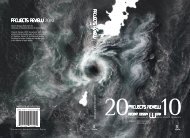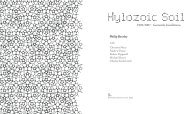The Inner Studio - Riverside Architectural Press
The Inner Studio - Riverside Architectural Press
The Inner Studio - Riverside Architectural Press
You also want an ePaper? Increase the reach of your titles
YUMPU automatically turns print PDFs into web optimized ePapers that Google loves.
PART FOUR | INNER KNOW-HOW<br />
<strong>The</strong> answer is not to suppress, steamroll, or ignore that childlike<br />
part of us, but to become aware of our own emotional needs.<br />
Once they have been identified, we can take responsibility for our<br />
own needs rather than expecting others to mother and father us.<br />
<strong>The</strong>re are times when a playful, honest mind is our greatest<br />
resource. A raw, stubborn determination may be necessary to safeguard<br />
an important design principle. But there is a great deal of<br />
skill required to bring our best decisions through to the built<br />
world. <strong>The</strong> line between child and adult is a fine line that is easily<br />
crossed and, once crossed, usually results in endless misdirection,<br />
suffering, and confusion. Our work has unconsciously slipped into<br />
the part of ourselves that is least equipped to solve the problems we<br />
are facing. It is extremely unfair to ask a child to carry responsibility<br />
for decision making in areas where he or she has no real<br />
expertise or experience. A simple start to addressing this is to work<br />
with the above diagram to bring your own adult and childlike<br />
needs to the surface and let this knowledge accompany you into<br />
the inner studio. This can be done by writing out the childlike and<br />
adult qualities you are aware of in yourself. Use this diagram as a<br />
way to track this attributes and, if you are experiencing a difficult<br />
time, carry it with you.<br />
Drawing First Drawings<br />
Mozart sat down and wrote entire symphonies in a single sitting.<br />
Perhaps, for a genius, inspiration comes in such long, sustained<br />
pulsations. But for most of us, the act of creation is incremental<br />
and involves working with glorious hints and many hard-to-decipher<br />
moments. It is often a process of three steps forward, followed<br />
by at least two steps back. Eight steps forward promises seven<br />
steps back. <strong>The</strong> fortunate thing is that you need very little to begin.<br />
All you need are two things: a glimpse, drop, moment, or simple<br />
clue, and a willingness to make a drawing that represents that<br />
image. That’s all you need. If you have that and approach it gently<br />
and gather it in and appreciate it, then the act of designing is<br />
underway.<br />
<strong>The</strong>re is always a great temptation to get to the end of the project<br />
before a clear beginning has been established. Giving in to this<br />
131





